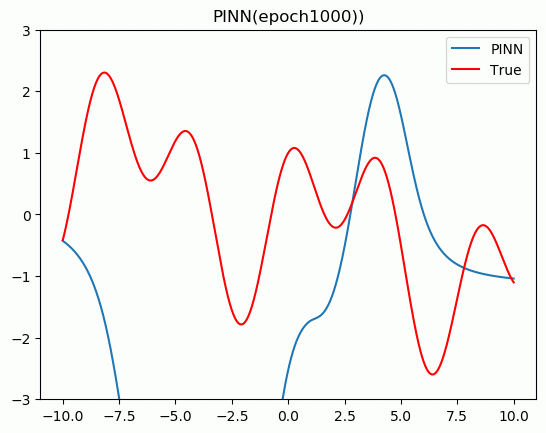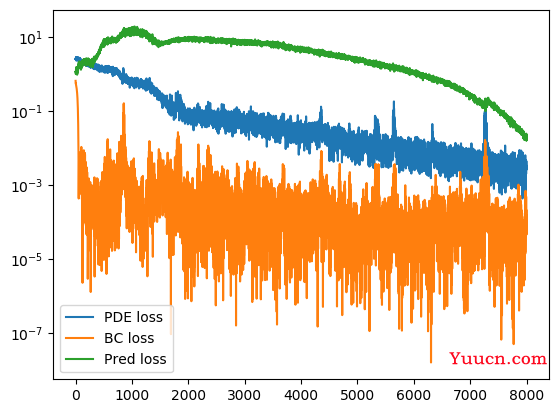下面我将介绍内嵌物理知识神经网络(PINN)求解微分方程。首先介绍PINN基本方法,并基于Pytorch框架实现求解一维Poisson方程。
内嵌物理知识神经网络(PINN)入门及相关论文
深度学习求解微分方程系列一:PINN求解框架(Poisson 1d)
深度学习求解微分方程系列二:PINN求解burger方程正问题
深度学习求解微分方程系列三:PINN求解burger方程逆问题
深度学习求解微分方程系列四:基于自适应激活函数PINN求解burger方程逆问题
1.PINN简介
神经网络作为一种强大的信息处理工具在计算机视觉、生物医学、 油气工程领域得到广泛应用, 引发多领域技术变革.。深度学习网络具有非常强的学习能力, 不仅能发现物理规律, 还能求解偏微分方程.。近年来,基于深度学习的偏微分方程求解已是研究新热点。内嵌物理知识神经网络(PINN)是一种科学机器在传统数值领域的应用方法,能够用于解决与偏微分方程 (PDE) 相关的各种问题,包括方程求解、参数反演、模型发现、控制与优化等。
2.PINN方法
PINN的主要思想如图1,先构建一个输出结果为
u
^
\hat{u}
u的神经网络,将其作为PDE解的代理模型,将PDE信息作为约束,编码到神经网络损失函数中进行训练。

损失函数主要包括4部分:偏微分结构损失(PDE loss),边值条件损失(BC loss)、初值条件损失(IC loss)以及真实数据条件损失(Data loss)。特别的,考虑下面这个的PDE问题,其中PDE的解
u
(
x
)
u(x)
u(x)在
Ω
⊂
R
d
\Omega \subset \mathbb{R}^{d}
Ω⊂Rd定义,其中
x
=
(
x
1
,
…
,
x
d
)
\mathbf{x}=\left(x_{1}, \ldots, x_{d}\right)
x=(x1,…,xd):
f
(
x
;
∂
u
∂
x
1
,
…
,
∂
u
∂
x
d
;
∂
2
u
∂
x
1
∂
x
1
,
…
,
∂
2
u
∂
x
1
∂
x
d
)
=
,
x
∈
Ω
f\left(\mathbf{x} ; \frac{\partial u}{\partial x_{1}}, \ldots, \frac{\partial u}{\partial x_{d}} ; \frac{\partial^{2} u}{\partial x_{1} \partial x_{1}}, \ldots, \frac{\partial^{2} u}{\partial x_{1} \partial x_{d}} \right)=0, \quad \mathbf{x} \in \Omega
f(x;∂x1∂u,…,∂xd∂u;∂x1∂x1∂2u,…,∂x1∂xd∂2u)=0,x∈Ω
同时,满足下面的边界
B
(
u
,
x
)
=
on
∂
Ω
\mathcal{B}(u, \mathbf{x})=0 \quad \text { on } \quad \partial \Omega
B(u,x)=0 on ∂Ω
为了衡量神经网络
u
^
\hat{u}
u和约束之间的差异,考虑损失函数定义:
L
(
θ
)
=
w
f
L
P
D
E
(
θ
;
T
f
)
+
w
i
L
I
C
(
θ
;
T
i
)
+
w
b
L
B
C
(
θ
,
;
T
b
)
+
w
d
L
D
a
t
a
(
θ
,
;
T
d
a
t
a
)
\mathcal{L}\left(\boldsymbol{\theta}\right)=w_{f} \mathcal{L}_{PDE}\left(\boldsymbol{\theta}; \mathcal{T}_{f}\right)+w_{i} \mathcal{L}_{IC}\left(\boldsymbol{\theta} ; \mathcal{T}_{i}\right)+w_{b} \mathcal{L}_{BC}\left(\boldsymbol{\theta},; \mathcal{T}_{b}\right)+w_{d} \mathcal{L}_{Data}\left(\boldsymbol{\theta},; \mathcal{T}_{data}\right)
L(θ)=wfLPDE(θ;Tf)+wiLIC(θ;Ti)+wbLBC(θ,;Tb)+wdLData(θ,;Tdata)
式中:
L
P
D
E
(
θ
;
T
f
)
=
1
∣
T
f
∣
∑
x
∈
T
f
∥
f
(
x
;
∂
u
^
∂
x
1
,
…
,
∂
u
^
∂
x
d
;
∂
2
u
^
∂
x
1
∂
x
1
,
…
,
∂
2
u
^
∂
x
1
∂
x
d
)
∥
2
2
L
I
C
(
θ
;
T
i
)
=
1
∣
T
i
∣
∑
x
∈
T
i
∥
u
^
(
x
)
−
u
(
x
)
∥
2
2
L
B
C
(
θ
;
T
b
)
=
1
∣
T
b
∣
∑
x
∈
T
b
∥
B
(
u
^
,
x
)
∥
2
2
L
D
a
t
a
(
θ
;
T
d
a
t
a
)
=
1
∣
T
d
a
t
a
∣
∑
x
∈
T
d
a
t
a
∥
u
^
(
x
)
−
u
(
x
)
∥
2
2
\begin{aligned} \mathcal{L}_{PDE}\left(\boldsymbol{\theta} ; \mathcal{T}_{f}\right) &=\frac{1}{\left|\mathcal{T}_{f}\right|} \sum_{\mathbf{x} \in \mathcal{T}_{f}}\left\|f\left(\mathbf{x} ; \frac{\partial \hat{u}}{\partial x_{1}}, \ldots, \frac{\partial \hat{u}}{\partial x_{d}} ; \frac{\partial^{2} \hat{u}}{\partial x_{1} \partial x_{1}}, \ldots, \frac{\partial^{2} \hat{u}}{\partial x_{1} \partial x_{d}} \right)\right\|_{2}^{2} \\ \mathcal{L}_{IC}\left(\boldsymbol{\theta}; \mathcal{T}_{i}\right) &=\frac{1}{\left|\mathcal{T}_{i}\right|} \sum_{\mathbf{x} \in \mathcal{T}_{i}}\|\hat{u}(\mathbf{x})-u(\mathbf{x})\|_{2}^{2} \\ \mathcal{L}_{BC}\left(\boldsymbol{\theta}; \mathcal{T}_{b}\right) &=\frac{1}{\left|\mathcal{T}_{b}\right|} \sum_{\mathbf{x} \in \mathcal{T}_{b}}\|\mathcal{B}(\hat{u}, \mathbf{x})\|_{2}^{2}\\ \mathcal{L}_{Data}\left(\boldsymbol{\theta}; \mathcal{T}_{data}\right) &=\frac{1}{\left|\mathcal{T}_{data}\right|} \sum_{\mathbf{x} \in \mathcal{T}_{data}}\|\hat{u}(\mathbf{x})-u(\mathbf{x})\|_{2}^{2} \end{aligned}
LPDE(θ;Tf)LIC(θ;Ti)LBC(θ;Tb)LData(θ;Tdata)=∣Tf∣1x∈Tf∑∥∥∥∥f(x;∂x1∂u,…,∂xd∂u;∂x1∂x1∂2u,…,∂x1∂xd∂2u)∥∥∥∥22=∣Ti∣1x∈Ti∑∥u(x)−u(x)∥22=∣Tb∣1x∈Tb∑∥B(u,x)∥22=∣Tdata∣1x∈Tdata∑∥u(x)−u(x)∥22
w
f
w_{f}
wf,
w
i
w_{i}
wi、
w
b
w_{b}
wb和
w
d
w_{d}
wd是权重。
T
f
\mathcal{T}_{f}
Tf,
T
i
\mathcal{T}_{i}
Ti、
T
b
\mathcal{T}_{b}
Tb和
T
d
a
t
a
\mathcal{T}_{data}
Tdata表示来自PDE,初值、边值以及真值的residual points。这里的
T
f
⊂
Ω
\mathcal{T}_{f} \subset \Omega
Tf⊂Ω是一组预定义的点来衡量神经网络输出
u
^
\hat{u}
u与PDE的匹配程度。
3.求解问题定义
d
2
u
d
x
2
=
−
0.49
⋅
sin
(
0.7
x
)
−
2.25
⋅
cos
(
1.5
x
)
u
(
−
10
)
=
−
sin
(
7
)
+
cos
(
15
)
+
1
u
(
10
)
=
sin
(
7
)
+
cos
(
15
)
−
1
\begin{aligned} \frac{\mathrm{d}^2 u}{\mathrm{~d} x^2} &=-0.49 \cdot \sin (0.7 x)-2.25 \cdot \cos (1.5 x) \\ u(-10) &=-\sin (7)+\cos (15)+1 \\ u(10) &=\sin (7)+\cos (15)-1 \end{aligned}
dx2d2uu(−10)u(10)=−0.49⋅sin(0.7x)−2.25⋅cos(1.5x)=−sin(7)+cos(15)+1=sin(7)+cos(15)−1
真实解为
u
:
=
sin
(
0.7
x
)
+
cos
(
1.5
x
)
−
0.1
x
u:=\sin (0.7 x)+\cos (1.5 x)-0.1 x
u:=sin(0.7x)+cos(1.5x)−0.1x
4.结果展示

